Plot and themes
In this novel, Mary Shelley returned to The Last Man 's message that an idealistic political system is impossible without an improvement in human nature. [2] This historical novel, influenced by those of Sir Walter Scott, [3] fictionalises the exploits of Perkin Warbeck, a pretender to the throne of King Henry VII who claimed to be Richard, Duke of York, the second son of King Edward IV.
Shelley believed that Warbeck really was Richard and had escaped from the Tower of London. [4] She endows his character with elements of Percy Shelley, portraying him sympathetically as "an angelic essence, incapable of wound", who is led by his sensibility onto the political stage. [5] She seems to have identified herself with Richard's wife, Lady Katherine Gordon, who survives after her husband's death by compromising with his political enemies. [6]
Lady Gordon stands for the values of friendship, domesticity and equality; through her, Mary Shelley offers a female alternative to the masculine power politics that destroy Richard, as well as the typical historical narrative which only relates those events. [7]
Shelley also creates a strong female character in the round-faced, half-Moor, half-Fleming, Monina de Faro, Richard's adoptive sister, whom Robin Clifford demands as his wife. Monina is a versatile young lady who acts as decoy, messenger, and military organizer, in addition to her close friendship with both Richard and Katherine. Robin Clifford epitomizes mixed loyalties—an old friend descended from Lancastrians, who is constantly divided against himself. Stephen Frion, secretary to Henry VII and betrayed by him, is an elder foil, whose loyalties shift back and forth dependent on Henry's grace, whereas Clifford's wavering is based on genuine emotion.
The book opens immediately after the Battle of Bosworth on August 22, 1485 (a scanning error in the Dodo Press 2000 edition gives the date as 1415). Three knights are fleeing from the battle, Sir Henry Stafford, Lord Lovel, and Edmund Plantagenet, although the latter two are not identified until they split from Stafford and arrive at a church. All three are members of the defeated Yorkist contingency.
With the aid of John de la Pole, the Earl of Lincoln, Lovel and Edmund are involved in spiriting away Richard, Duke of York into the hands of Mynheer Jahn Warbeck, a Flemish moneylender who had previously housed him and pretended that Richard was his deceased son, Perkin Warbeck. This is not considered safe enough for the youth at the present time, so it is arranged for Richard to go with Madeline de Faro, Warbeck's 25-year-old sister. Madeline is married to mariner Hernan de Faro, and the two have a daughter named Monina, and Richard and Monina develop a strong sibling bond, Richard aware he could never marry a commoner. It is she who rescues and nurses him back to health after his first taste of battle in the Granada War.

Henry VII was King of England and Lord of Ireland from his seizure of the crown on 22 August 1485 until his death in 1509. He was the first monarch of the House of Tudor.

Perkin Warbeck was a pretender to the English throne claiming to be Richard of Shrewsbury, Duke of York, who was the second son of Edward IV and one of the so-called "Princes in the Tower". Richard, were he alive, would have been the rightful claimant to the throne, assuming that his elder brother Edward V was dead and that he was legitimate—a point that had been previously contested by his uncle, King Richard III.

Lambert Simnel was a pretender to the throne of England. In 1487, his claim to be Edward Plantagenet, 17th Earl of Warwick, threatened the newly established reign of Henry VII (1485–1509). Simnel became the figurehead of a Yorkist rebellion organised by John de la Pole, Earl of Lincoln. The rebellion was crushed in 1487. Simnel was pardoned because of his tender years, and was thereafter employed by the royal household as a scullion.
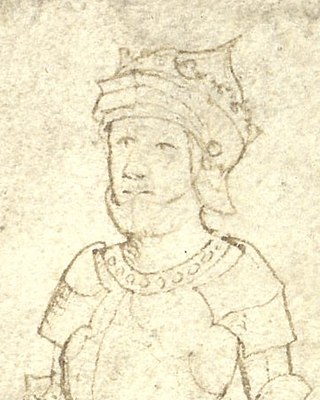
Edward Plantagenet, 17th Earl of Warwick was the son of Isabel Neville and George Plantagenet, 1st Duke of Clarence, and a potential claimant to the English throne during the reigns of both his uncle, Richard III (1483–1485), and Richard's successor, Henry VII (1485–1509). He was also a younger brother of Margaret Pole, 8th Countess of Salisbury. Edward was tried and executed for treason in 1499.

Earl of Derby is a title in the Peerage of England. The title was first adopted by Robert de Ferrers, 1st Earl of Derby, under a creation of 1139. It continued with the Ferrers family until the 6th Earl forfeited his property toward the end of the reign of Henry III and died in 1279. Most of the Ferrers property and the Derby title were then held by the family of Henry III. The title merged in the Crown upon Henry IV's accession to the throne in 1399.

Ralph Neville, 1st Earl of WestmorlandEarl Marshal, was an English nobleman of the House of Neville.
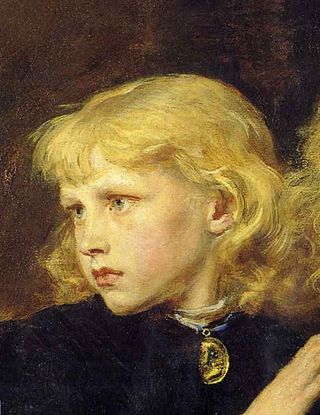
Richard of Shrewsbury, Duke of York, was the sixth child and second son of King Edward IV of England and Elizabeth Woodville, born in Shrewsbury. Richard and his older brother, who briefly reigned as King Edward V of England, mysteriously disappeared shortly after their uncle Richard III became king in 1483.
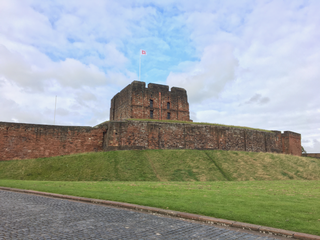
Carlisle Castle is a stone keep medieval fortress located in the city of Carlisle near the ruins of Hadrian's Wall. First built during the reign of William II in 1092 and rebuilt in stone under Henry I in 1122, the castle is over 930 years old and has been the scene of many episodes in British history.

Sir William StanleyKG was an English soldier and the younger brother of Thomas Stanley, 1st Earl of Derby. Stanley fought with his troops in several battles of the Wars of the Roses.
Sir James OrmondaliasButler was the son of John Butler, 6th Earl of Ormond. He was Lord Treasurer of Ireland from 1492 to 1494, and helped to defend the Lordship of Ireland against the forces of Perkin Warbeck. He was murdered by Sir Piers Butler on 17 July 1497. Piers would later hold the title of Earl of Ormond.
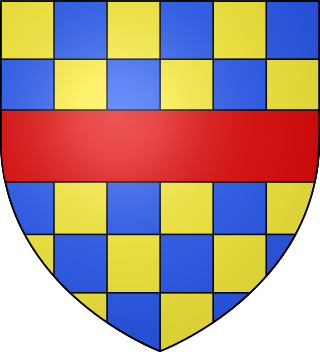
John Clifford, 9th Baron Clifford, 9th Lord of Skipton was a Lancastrian military leader during the Wars of the Roses in England. The Clifford family was one of the most prominent families among the northern English nobility of the fifteenth century, and by the marriages of his sisters, John Clifford had links to some very important families of the time, including the earls of Devon. He was orphaned at twenty years of age when his father was slain by partisans of the House of York at the first battle of the Wars of the Roses, the Battle of St Albans in 1455. It was probably as a result of his father's death there that Clifford became one of the strongest supporters of Margaret of Anjou, wife of King Henry VI, who ended up as effective leader of the Lancastrian faction.

Thomas Clifford, 8th Baron de Clifford, also 8th Lord of Skipton, was the elder son of John, 7th Baron de Clifford, and Elizabeth Percy, daughter of Henry "Hotspur" Percy and Elizabeth Mortimer.
Events from the 1480s in England. This decade marks the beginning of the Tudor period.
Events from the 1490s in England.

John Clifford, 7th Baron de Clifford, also known as John, Lord Clifford, 7th Lord of the Honor of Skipton, KG, was an English peer. He was killed at the siege of Meaux, France.
Honouring individuals buried in Westminster Abbey has a long tradition. Over 3,300 people are buried or commemorated in the abbey. For much of the abbey's history, most of the people buried there besides monarchs were people with a connection to the church – either ordinary locals or the monks of the abbey itself, who were generally buried without surviving markers. Since the 18th century, it has become a prestigious honour for any British person to be buried or commemorated in the abbey, a practice much boosted by the lavish funeral and monument of Isaac Newton, who died in 1727. By 1900, so many prominent figures were buried in the abbey that the writer William Morris called it a "National Valhalla".
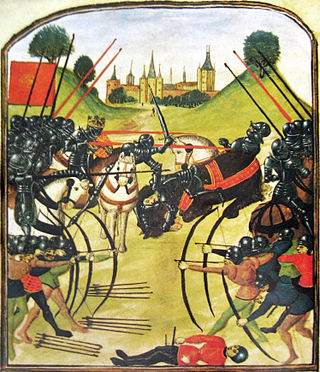
The Wars of the Roses (1455–1487), known at the time and for more than a century after as the Civil Wars, was a series of civil wars fought over control of the English throne in the mid-to-late fifteenth century. These wars were fought between supporters of two rival cadet branches of the royal House of Plantagenet: Lancaster and York. The wars extinguished the last male line of the House of Lancaster in 1471, leading to the Tudor family inheriting the Lancastrian claim to the throne. Following the war and the extinction of the last male line of the House of York in 1485, a politically arranged marriage united the Houses of Lancaster and York, creating a new royal dynasty which inherited the Yorkist claim as well, thereby resolving the conflict.

Sir John Savage, KG, KB, PC (1444–1492), was an English knight of the Savage family, who was a noted military commander of the late 15th-century. Savage most notably fought at the Battle of Bosworth Field in 1485, where he commanded the left flank of the Tudor (Lancastrian) army to victory and is said to have personally slain the Duke of Norfolk in single combat. Earlier in the Wars of the Roses, Savage had been a supporter and friend of the Yorkist King Edward IV, fighting alongside him and helping him to victories at the Battle of Barnet in 1471 and the Battle of Tewkesbury later that same year, as well as joining the Duke of Gloucester's invasion of Scotland in 1482, where the Duke made him a Knight banneret. However, following the death of Edward and the Duke of Gloucester's ascension to the throne as Richard III the Savage family was viewed with suspicion due to their familial connection to the Stanleys, who were in turn connected to the Tudors. Consequently Savage was one of the prominent figures who invited Henry Tudor to invade England in 1485, a struggle which culminated in the Battle of Bosworth Field. After his victory Henry Tudor received the circlet of Richard from Savage's uncle Lord Stanley and was crowned King of England on the field of battle, taking the throne as Henry VII of England.














